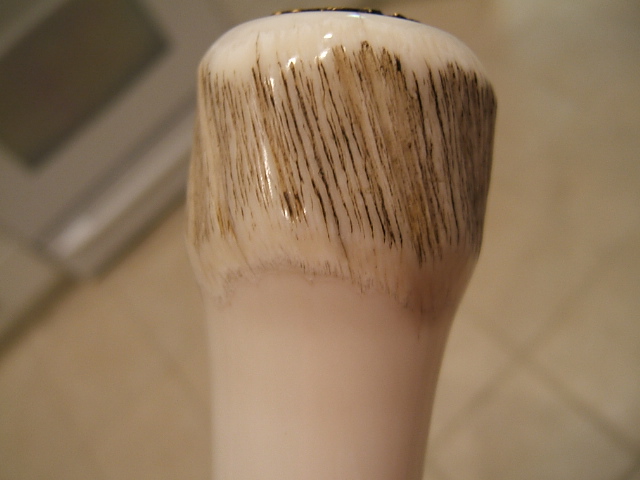 Narwhal (8909) Narwhal (8909)
Previous to this week, you could stick what I knew about Narwhal tusk canes in the proverbial thimble. I had a visit with Charles Daughterty of Ohio and was surprised by how much someone who had no water around his state could be so knowledgeable. I have had one for many years, but never knew much more than what the surface of the tusk looked like, that the canes were made by the whalers from a single tusk that sticks out of the head of the Narwhal, causing them to look like a unicorn horn. I saw one once that was over 12' long and 4" diameter at the end that was attached to the whale, and it was priced at $20,000. It was just a tusk, not a cane, and although I knew it was hollow on the end I never thought much about what effect that would have on canes. The Narwhal cane above this one, which I bought from Michael German, a number of years ago has a plane silver cap covering the end, so I never knew it was hollow or wasn't hollow. Charles informed me it could be solid or hollow, as the hollow part went about half way down the tusk. If the end was solid it would mean a 36" cane would have come from a 6'tusk. I wondered why they would shorten a tusk so it was solid. One reason would be the end was damaged as they are quite fragile near the top, and they were often found on beaches after they were broken off. Another reason is that the whalers turned the shaft down, on foot powered lathe in the holds of ships, to look smooth and polished.. He showed me one he had, and I wondered why they would do that, as I liked the natural texture of the skin of the tusk. They did it to make the shaft of the cane look like a single piece of ivory, a very difficult thing to achieve with an elephant tusk. Again I ask why and he said," It's difficult to achieve because of the curve of the elephant tusk. To get a 3' straight shaft you need nearly 5' of curved tusk from the solid part, because when the hollow part starts, there is nothing to make the shaft from. Most ivory shafts are segmented, because of how wasteful it is to make a one piece shaft. I see very few one piece shafts and when you do they are very expensive. I still donít have a good handle on what they are worth as I see so few of them. It would be the same reason a narwhal tusk can only be turned at the solid part. Itís too fat and fragile to turn it much past that part. Todayís cane has a tortoise cap over the hollow end, which I would think only goes down a few inches. This cane is much heavier than my other narwhal, leaving me to assume more of the shaft is hollow. Charles also told me that one out of three shafts that were attempted to be turned shattered during the attempt, because Narwhal is brittle. Thatís a pretty high percentage. Because of that, turned tusk are worth more than natural ones, which again I didnít know. Nautical canes are a field in themselves. Iíve known for a long time that Narwhal,an endangered specie, is illegal to bring across country borders unless it is done by permit from our fishery and wildlife. That only antique ivory is legal and certification is necessary. When I brought my Narwhal cane in from England, Michael got the permit for that and all the other ivories I brought in, and I had no problems. Iím told today you can still bring in antique elephant ivories, but not Narwhal of any age. That if you get caught trying to do it illegally you will spend time in jail. I havenít ask Michael about this, but was told this by another collector who tried to bring an antique one in from England and was refused. Iím told you can buy new Narwhal in Canada, but donít try to bring it in to America, which is as it should be. I have been seeing new canes carved with mammoth ivory, hippo, fossilized walrus, and other legal ivories, because they are not on the endangered specie list. I never really thought about the fact, mammoth havenít roamed the earth for 10,000 years, so whatís to protect. One last opinion, elephant ivory cane handles bring more money than any other form of ivory, i.e. statues. I was also told that elephant tusk are bringing 150 a pound, whatís to stop an artist from making new handles that look old to the beginner? Learn how to tell the differences before you spend your money, or buy from sources you have recourse with.
Category: Handcarved - Folkart
Sub Category: Ivory
Listed: 2007-01-01 21:07:34
|










 Online Video
Online Video



